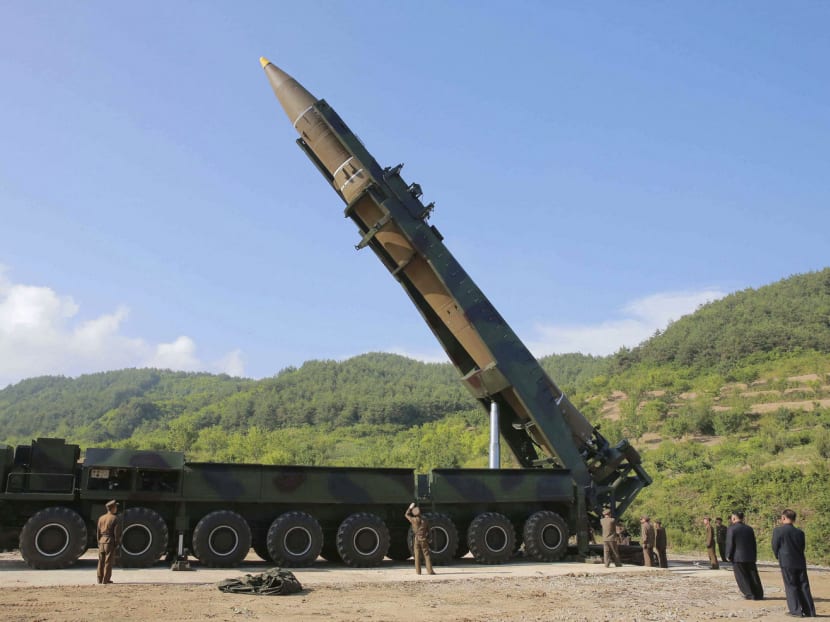N Korea could develop missile that can strike US within a year
WASHINGTON — American intelligence agencies have shortened their estimate — to one year — of how long it is likely to take North Korea to put the finishing touches on a missile that can reach the continental United States, according to several administration officials briefed on the new assessment.

A file photo released by North Korea on July 4 showing the Hwasong-14 intercontinental ballistic missile readying for launch. The launch has led US intelligence to reassess North Korea’s nuclear capabilities. Photo: AP
WASHINGTON — American intelligence agencies have shortened their estimate — to one year — of how long it is likely to take North Korea to put the finishing touches on a missile that can reach the continental United States, according to several administration officials briefed on the new assessment.
Until a few weeks ago, the official estimate was that it would take roughly four years, give or take 12 months, for North Korea to develop a missile that could carry a nuclear weapon small enough to fit into the missile’s warhead and capable of surviving the stresses of re-entry and deliver it to the US.
But the realities of the past few months, especially a July 4 test that crossed a major threshold — if just barely — has forced intelligence experts to conclude that their estimates have been too conservative. In the test this month, a missile carried a warhead 2,736km into space, and returned it at high speed in a sharp parabola.
If the trajectory was flattened out, the missile could strike Alaska. That forced government experts, reflexively cautious after overestimating Iraq’s weapons of mass destruction 14 years ago, back to the drawing board.
Behind the new assessment, officials said, was a growing recognition that they underestimated the determination of Mr Kim Jong-un, North Korea’s leader, to race ahead with a weapon that could reach American soil, even if it is crudely engineered and inaccurate.
General Paul Selva, the vice-chairman of the Joint Chiefs of Staff, put the best case forward last week when testifying before the Senate Armed Services Committee. The most recent test, he said, stopped short of demonstrating that North Korea possesses “the capacity to strike the United States with any degree of accuracy or reasonable confidence of success”.
But that statement went far beyond what most Pentagon officials had been allowed to say in public before the most recent test. And it reflects a growing view, from the Defence Intelligence Agency to the Central Intelligence Agency (CIA), that at this point Mr Kim’s missile engineers, while still refining the technology, have cleared most of the major hurdles.
It is unclear how, if at all, that will change the calculus for President Donald Trump. He has vowed to dispense with the Obama-era strategy of “strategic patience” towards North Korea.
American military officials have been asked to come up with new potential strategies, from stepped-up economic pressure to increased cyber attacks on the missile testing regimes. But there is a lurking sense, one senior intelligence official said last week at the Aspen Security Forum, that at this point the best the US can do is delay the day when North Korea demonstrates it can reach beyond Alaska and Hawaii.
“It’s a big long supply chain to build this thing out,” the director of the CIA, Mr Mike Pompeo, said at the security conference, the first public reference to a long-running covert programme to undermine the parts and technologies that flow into North Korea. “As for the regime, I am hopeful we will find a way to separate it” from its missile and nuclear capabilities.
But the essence of the new assessment, which was first reported by The Washington Post, is that Washington has no more time. If the 2018 estimate is right, North Korea will have a crude capability to reach the continental US before the nation’s missile defences are upgraded.
Quietly, the Pentagon has been refining long-standing contingency plans, from intercepting missile parts at sea to attempting, if Mr Trump should decide to do it, to destroy a missile on the launchpad before it is tested. But it is more likely that the US would first try a variant of the effort developed during the Obama administration to sabotage the launches with cyber and electronic warfare techniques, and with a steady flow of bad parts.
A spokesperson for the Office of the Director of National Intelligence issued a statement from Mr Scott Bray, the national intelligence manager for East Asia, that walked to the edge of acknowledging that judgments are shifting.
“North Korea’s recent test of an intercontinental range ballistic missile — which was not a surprise to the Intelligence Community — is one of the milestones that we have expected would help refine our timeline and judgments on the threats that Kim Jong-un poses to the continental United States,” Mr Bray wrote.
“This test, and its impact on our assessments, highlight the threat that North Korea’s nuclear and ballistic missile programmes pose to the United States, to our allies in the region, and to the whole world.”
The steady frequency of the North Korean missile tests, using a new solid fuel technology, came as a surprise to many intelligence experts, providing a different lesson than the one that emerged from Saddam Hussein’s weapons of mass destruction programme in Iraq.
In the Iraq case, the intelligence agencies overestimated Saddam’s ability to reconstitute what was once a healthy nuclear weapons programme. In the North Korean case, one senior intelligence official noted last week, the speed and sophistication of the programme have been consistently underestimated — much as it was with the Soviet Union 70 years ago, and China more than 50 years ago. THE NEW YORK TIMES






